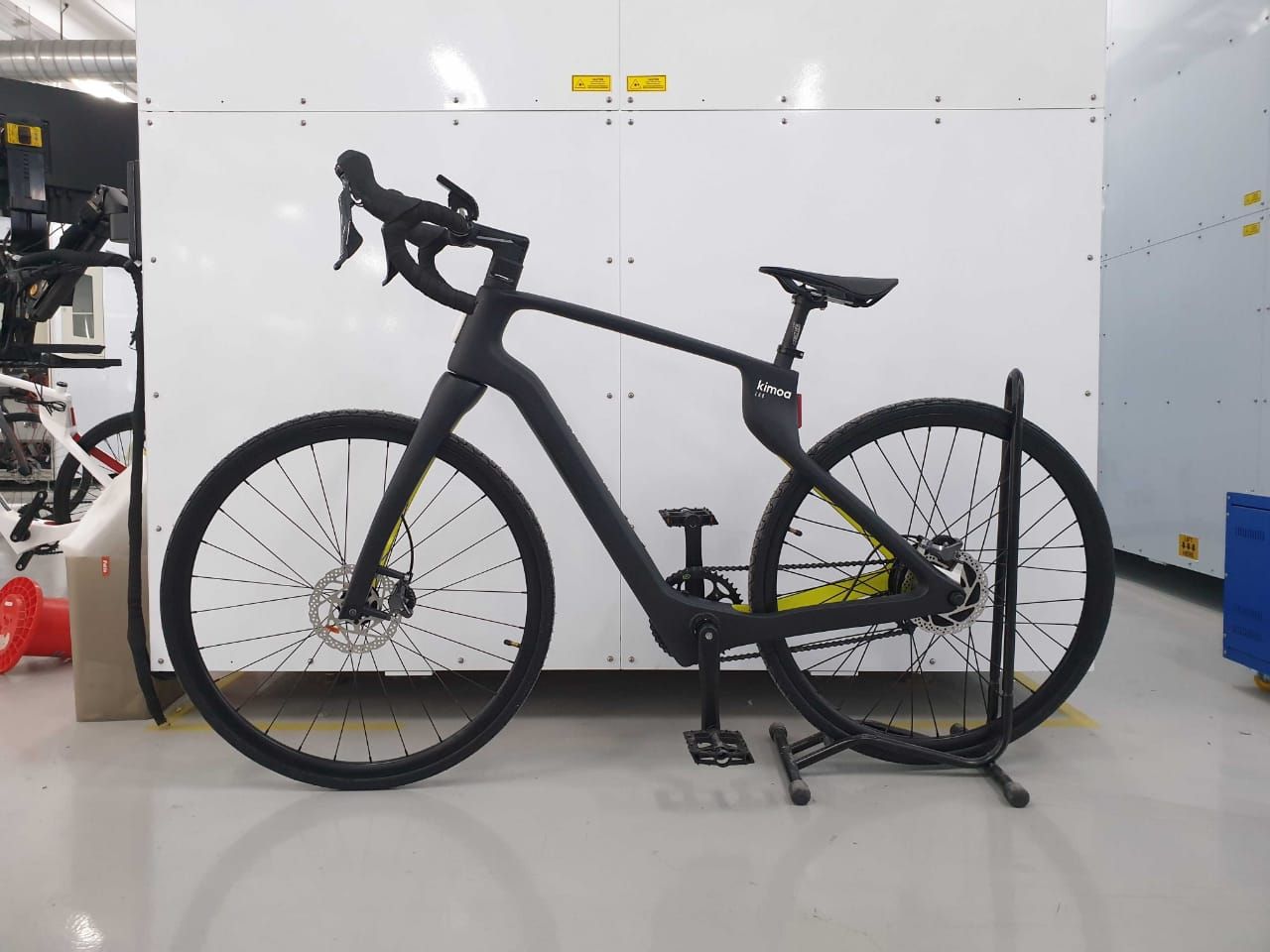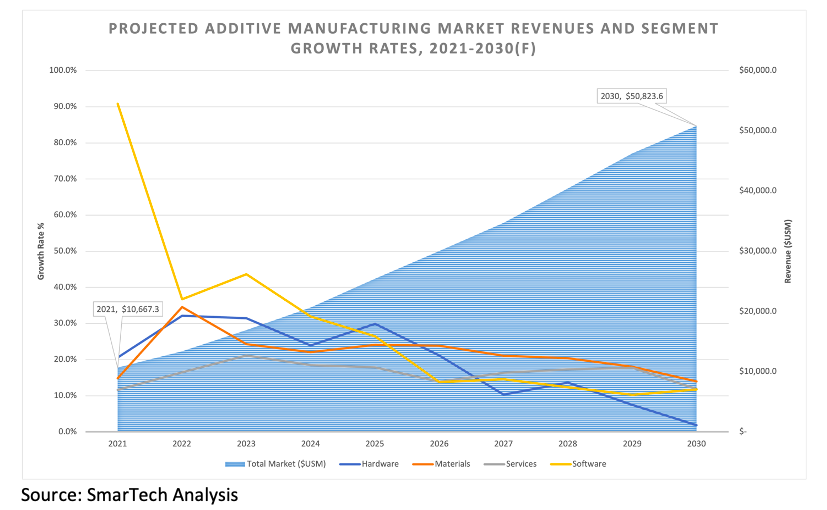While the additive manufacturing process has been around for 30 years, its use for production applications has recently accelerated because of improvements that enable faster production, high-quality materials, and larger volumes of industrial-grade parts. These technical improvements have led to business benefits such as supply chain agility and responsiveness, speed to scale, and, for low-volume production, there are cost advantages over other types of manufacturing.
The continuous evolution and improvements of additive manufacturing technologies and materials has led to increased business opportunities, and organizations are finding many ways to capitalize on these opportunities. Some manufacturing companies are exploring additive manufacturing as a new solution for part production in the midst of supply chain disruptions. Additionally, a report published by SmarTech Analysis revealed that additive manufacturing grew to about $10.6 billion in 2021.
The opportunities from additive manufacturing are so compelling that on May 6th, President Biden announced a new initiative that will boost the use of 3D printing in domestic supply. This initiative, called Additive Manufacturing Forward (AM Forward), plans to see large manufacturers such as GE Aviation, Honeywell, Lockheed Martin, Raytheon, and Siemens Energy partner with small, US-based suppliers to help them more thoroughly use 3D printing technology. In doing so, AM Forward will strengthen US supply chains, help lower costs, and encourage investment in small and medium-sized companies.
AM Forward marks an exciting moment in the growth of 3D printing as US government officials have recognized the value additive manufacturing provides and are making an effort to further accelerate its adoption in manufacturing practices. Many organizations are taking a fresh look at how additive manufacturing can benefit their businesses.
As businesses consider the best way to get started with additive manufacturing, we can look to three types of opportunities:
1. Creating Customized Products
Additive manufacturing is ideal for making individual and small batches of unique parts quickly and at low cost. Organizations making custom products, for example products with custom fits or having individual serial numbers, can easily generate the product designs using software, and then produce those designs with additive. Unlike traditional manufacturing processes that require tooling and manufacturing equipment setup, additive manufacturing requires no tooling which allows for parts to be printed directly with a minimum effort and cost to get started. Additive manufacturing allows you to deliver a fully custom product at a much lower cost thanks to the ease of customization with 3D technology.
Consider dentistry and orthodontics, for example. For years, conventional metal braces dominated the market. Then, Invisalign disrupted the industry with a new treatment modality manufactured with stereolithography. The product is tailored to each patient while being more comfortable than traditional braces, easier to use, and even more aesthetically appealing. Invisalign was able to leverage 3D printing technology to rapidly produce products that are tailored for each individual customer, which would be prohibitively expensive using traditional manufacturing methods.

The 3D printed e-bike from two-time Formula 1 champion Fernando Alonso’s lifestyle brand Kimoa. Image courtesy of Arevo.
Additive manufacturing provides customization opportunities that previously had been impractical. For motorsports-inspired brand Kimoa, using additive manufacturing allows them to create personalized 3D-printed carbon fiber composite e-bicycles. These customizable frames, created by Arevo, allow the user to order bikes according to their individual measurements and aesthetic preferences. By utilizing additive manufacturing, you can make products in less time and with more options for customization than ever before.
2. Exploring Novel Designs for Performance and Aesthetics
Because the additive manufacturing process is digitally driven, engineers have more creative liberty in their designs. You can achieve geometries with additive manufacturing that would be impossible to create with computer numerical control (CNC) machining or injection molding.
These novel geometries often improve technical performance because they enable you to get around constraints present in traditional manufacturing processes, allowing for features like undercuts and inaccessible holes. For example, lattices or organic structures can be made with additive manufacturing to create products with novel mechanical benefits, excellent shock absorption, and reduced material usage.
In one instance, Rawlings developed a baseball glove that replaced traditional foam or wool pads in the fingers with 3D printed elastomeric lattice parts that were lighter, thinner, and more durable. By utilizing the benefits of 3D printing, Rawlings was able to improve performance and create a better product that would hold up over time. Whereas traditional materials may break down or degrade over time, additive manufacturing allows for the use of innovative designs and materials that have high performance and longer useful lifetimes than similar products made using conventional manufacturing methods.
3. Producing Lower Volumes of Product
Additive manufacturing allows you to produce lower quantities at a better price per part because tooling is not required as in traditional manufacturing. Tool-less manufacturing can unlock new business opportunities for savvy manufacturers. Because 3D printing technology can often produce small batches of products within weeks, it is ideal for businesses wishing to quickly scale from rapid prototyping to low-volume production.
For example, rather than estimating demand and ending up with too much or too little of a product, you can enter the market with a smaller quantity of product to test its viability. Then, you can shift production rate up or down in response to market demands. You can also change the product design without incurring additional costs from new tooling.
Numerous opportunities are available for businesses to incorporate additive manufacturing into their daily production. AM Forward will further allow small and medium-sized companies to reap the benefits of additive manufacturing. The three types of opportunities covered here are available to companies of any size. Due to the many advantages of using 3D technology, engineers who choose to employ additive manufacturing will see these benefits in their own business.
About the Author
Bill King, Ph.D., is co-founder and chief scientist at Fast Radius, a cloud manufacturing and digital supply chain company. In 2018, the World Economic Forum named Fast Radius as a Lighthouse Factory, one of the world’s best digital factories.
Subscribe to Our Email Newsletter
Stay up-to-date on all the latest news from the 3D printing industry and receive information and offers from third party vendors.
You May Also Like
3D Printing Unpeeled: Orbex Investment, IndoMIM and HP, Ultrasonic Waves
INDO-MIM has bought three HP Metal Jet S100 printers, operating two in India and one in Texas. This is a win for HP because the company has deep experience in...
3D Printing News Briefs, April 3, 2024: Kickstarter FDM 3D Printer, Artificial Eyes, & More
In 3D Printing News Briefs today, we’re talking about an FDM 3D printer on Kickstarter, advancements in artificial eye creation, and 3D printed solenoids for electromagnets. Then we’ll move on...
Firestorm Gets $12.5M from Lockheed and Others to Automate Drone Production with 3D Printing
Firestorm Labs is advancing an initiative that has been a topic of discussion on our site for a while: automating drone swarm production. Drones are increasingly altering the landscape of...
3D Printing Leaders Team with Rivelin for Robotic Metals Post-processing
UK-based Rivelin Robotics is working on creating a manufacturing cell to automate the post-processing of metal 3D printed parts. If successful, this approach could reduce the costs of metal 3D...
































